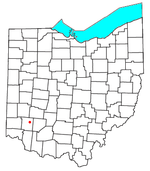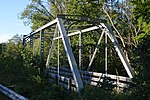Fort Ancient (Lebanon, Ohio)

Fort Ancient (33 WA 2) is a Native American earthworks complex located in Washington Township, Warren County, Ohio, along the eastern shore of the Little Miami River about seven miles (11 km) southeast of Lebanon on State Route 350. The site is the largest prehistoric hilltop enclosure in the United States with three and one-half miles (18,000 ft) of walls in a 100-acre (0.40 km2) complex. Built by the Hopewell culture, who lived in the area from the 200 BC to AD 400, the site is situated on a wooded bluff 270 feet (82 m) above the Little Miami. It is the namesake of a culture known as Fort Ancient who lived near the complex long after it was constructed. Maintained as a state historical park, the site was designated a National Historic Landmark for its significance. The State of Ohio purchased the land and made it Ohio's first state park in 1891. In addition, this is part of the Hopewell Ceremonial Earthworks, one of 14 sites nominated in January 2008 by the U.S. Department of the Interior for potential submission by the United States to the UNESCO World Heritage List. It was officially designated a World Heritage Site in September 2023 together with the earthworks at Hopewell Culture National Historical Park and the Newark Earthworks.
Excerpt from the Wikipedia article Fort Ancient (Lebanon, Ohio) (License: CC BY-SA 3.0, Authors, Images).Fort Ancient (Lebanon, Ohio)
SR 350,
Geographical coordinates (GPS) Address Nearby Places Show on map
Geographical coordinates (GPS)
| Latitude | Longitude |
|---|---|
| N 39.407783333333 ° | E -84.090252777778 ° |
Address
SR 350 6377
45054
Ohio, United States
Open on Google Maps







